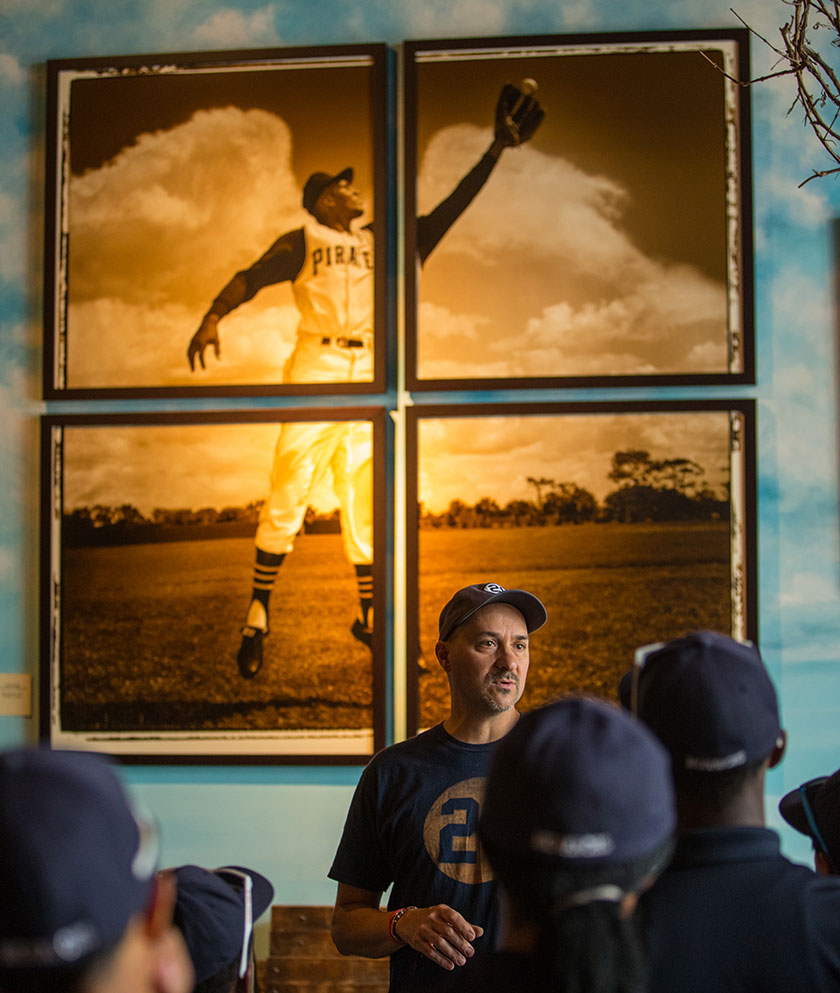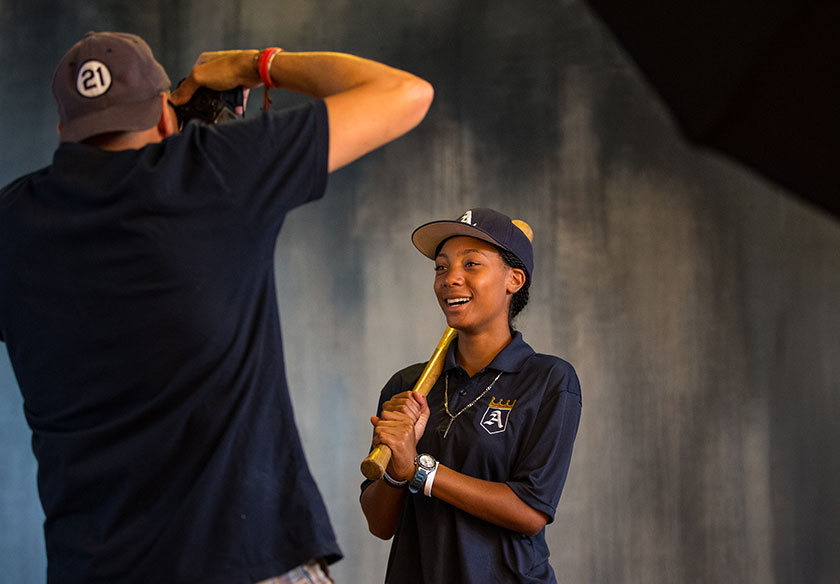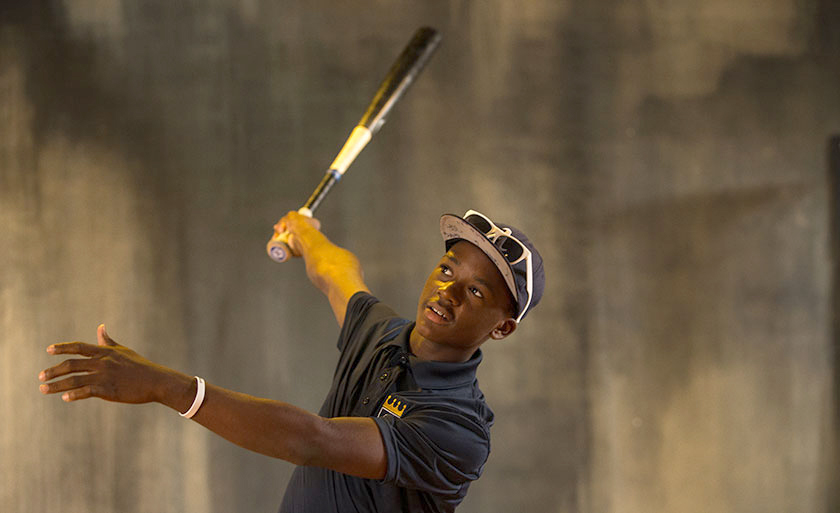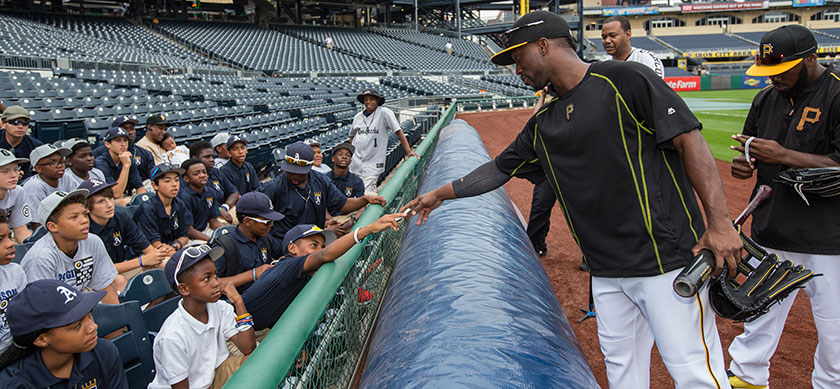Angel In the Outfield
Friday July 3. Day 17 of the Anderson Monarchs Civil Rights Barnstorming Tour started late thanks to a "no wakeup call" morning. Unfortunately I don't have the sleep-in gene, and I do have a cat who eats at 5am, so I was up early by habit.
The itinerary called for only a Pirates-Indians game at PNC Park, but the always evolving schedule suddenly included a Roberto Clemente Museum trip at 2pm. For all the times I've been to the other side of my own state, I'd never even heard of this place.
I was 10 when Clemente died in a plane crash flying from Puerto Rico to Nicaragua with emergency relief supplies for earthquake victims. I heard about it at church on New Years Day, 1973. Clemente accompanied the flight the previous night, because he'd heard that the corrupt Somoza government had not allowed previous shipments to reach the victims. Clemente's body was never recovered.
I don't recall seeing Clemente play. 1972 was my first year following baseball, and while I watched the Reds-Pirates NLCS, I only recall the final pitch of Game 5, a Bob Moose wild pitch that allowed George Foster to score the run that ended the Pirates season.
I knew of Clemente only through TV clips and the baseball books and magazine articles I read obsessively. Everything revealed not just a superior ball player, but one for whom accepted baseball mechanics were simply not necessary...his athleticism and stylish play made him a star. His humanity and concern for others set him apart. My oldest son Aaron loved baseball as a young boy, and I taught him about Clemente and Jackie Robinson as men of character. On a trip to Cooperstown when our youngest was playing a tournament at Dreams Park, Aaron returned from shopping with Clemente and Robinson T-shirts that he wore until he outgrew them in High School. I was not a Clemente fan, but I held him in high regard.
Duane Rieder is, to say the least, a Clemente fan.
The nondescript Clemente Museum looked like it was closed when we pulled up. And, in fact, it was, because tours are conducted by appointment only. When the Monarchs and the Josh Gibson team we played last night gathered by the front door, Duane opened shop and let us in.
The museum is built into the old Engine House 25 where Rieder, a photographer by trade, has a studio. The museum, however, now takes up majority of the building.
The museum is incredible. It is the best single-person collection I have ever seen, and the display and specific items are truly unique. Rieder claims to have a personal relationship with the Clemente family, and the care with which he honors their patriarch bears that out. He speaks reverently about Clemente, and makes circumstantial connections that are intriguing, nonetheless.
The most impressive piece, which hangs just inside the front door, is a huge, quartered photograph of Clemente, jumping in the air, a ball just about to settle into his mitt. Very typical of the posed-action images photographers shot in the past, this image however, has a cloud formation that appears to give Clemente angel wings.

Rieder claims this image was part of a Pittsburgh newspaper collection which he purchased after it was discarded, and retrieved from the trash. He explains the image was never published, and was simply a series of several images the unnamed photographer took the same day. (There is a similar, smaller Mazeroski print displayed adjacent to this print with no cloud formation.) If this image was truly never published, I would consider it one of the all-time gaffes in photojournalism. If it was published, or even known to exist, well that would be worse. The image is stunning, and borders on unbelievable because of its perfection: A beloved athlete, killed on a mercy mission, levitating perfectly in front of clouds that make him appear angelic.
(Here's a comment from Alabama photographer Kevin Glackmeyer regarding the origin of the Clemente image noted in the blog post below. "The iconic, seemingly fabricated photograph of Roberto Clemente jumping for a fly ball at Terry Park, is one of the most recognizable photos in baseball history but the story behind the photo is the incredible part. Clouds shaped like wings of an angel appear in the background behind Clemente. The negative of the photo, was taken sometime before 1960 at Terry Park by Jim Klingensmith of the Pittsburgh Post-Gazette. It was recovered from a trash container in 1991 in pieces, and was reconstructed to display the amazingly well- timed photograph. The photo was stored in a box for seven years and then bought and displayed at the Clemente Museum in Pittsburgh where it remains today.")
The rest of the tour includes documents (including a contract negotiation, conducted by mailed letters, between Clemente and Branch Rickey), a collection of every Clemente baseball card in near mint condition, and countless photographs, and game used artifacts from Clemente's career and peers. Rieder purchased or traded for most of the collection, unlike the Baseball Hall of Fame which accepts only donated items.
Rieder takes great pride in giving tours to young black and Latino MLB players, who may not fully appreciate the details of Clemente's life. He aspires to grow the museum into a school-trip destination, to keep the story of Clemente alive for future generations.
The museum, clearly a work of passion for Rieder, is funded by a wine making business run out of the basement. That tour, reserved for only the adults in our group, was as impressive as the museum, with a meticulously designed wine cellar, barrel storage and winemaking room that was simultaneously chaotic and organized.
Below are some more images from the Monarchs visit to the museum and PNC Park.
 Home Plate from the 1971 World Series, and cleats from Clemente's final season
Home Plate from the 1971 World Series, and cleats from Clemente's final season
 In the Manny Sanguillen Room, Rieder compares the former Pirates catcher's large bat to Andrew McCutcheon's
In the Manny Sanguillen Room, Rieder compares the former Pirates catcher's large bat to Andrew McCutcheon's
 Rieder, a photographer by trade, poses Mo'ne Davis.
Rieder, a photographer by trade, poses Mo'ne Davis.

Sami Wylie, a master of coaxing swag from players, succeeded only in getting permission to pose with Rieder's Yasiel Puig bat
 The basement of the museum is a wine making operation that funds the museum
The basement of the museum is a wine making operation that funds the museum
 Custom made barrels of wine are ordered at a cost of $12,000.
Custom made barrels of wine are ordered at a cost of $12,000.
 Andrew McCutcheon, reaching for a Monarchs wristband, and Josh Harrison visit with the Monarchs and Josh Gibson team during BP.
Andrew McCutcheon, reaching for a Monarchs wristband, and Josh Harrison visit with the Monarchs and Josh Gibson team during BP.
 The Monarchs shot pool in the lounge adjacent to the suite before the game
The Monarchs shot pool in the lounge adjacent to the suite before the game
 The players hung outside during the almost constant rain that fell during the game
The players hung outside during the almost constant rain that fell during the game

